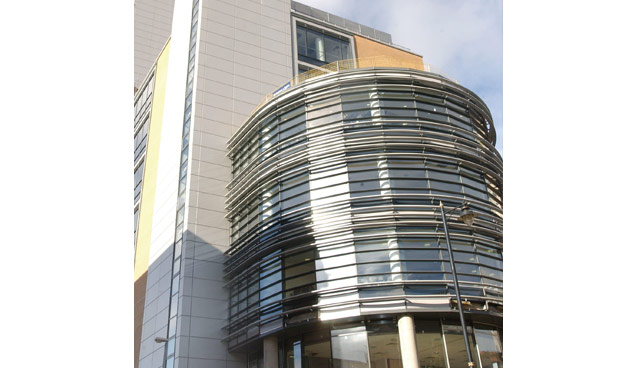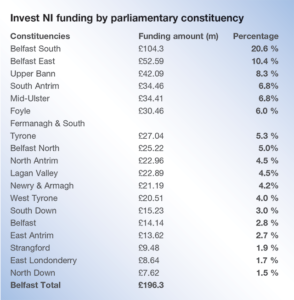Invest NI: East-west divide in investment

Invest NI, the public body founded with the aim of supporting business development and entrepreneurship in Northern Ireland has provided over £500 million in funding over recent years – with much of that funding allocated to Belfast and its surrounding areas. agendaNi analyses the breakdown of allocated funds.
Investing in the future
Founded in 2002, Invest Northern Ireland has invested a total of £510.13 million in financial assistance from 2013-14 to 2017-18. By addressing the population differences using a per capita basis, the east received £283.83 million and the west received £237.83 million – representing a sizeable difference of 16.21 per cent. This figure excludes money given to non-business organisations such as external delivery organisations and universities.
As has been the case since Invest NI’s inception, the majority of its funding has been allocated to businesses and organisations within the Belfast City Council area, with £186.3 million of investment in that area representing 36.52 per cent of all money provided by the agency over a four-year period. The agency has attributed the apparent preference given to Belfast to its high concentration of businesses within its boundaries.
When examined on a parliamentary constituency basis, three areas can be seen as receiving the highest portions of Invest NI funding: South Belfast (£104.3 million), East Belfast (£52.59 million) and Upper Bann (£42.09 million). The funding received by these areas contrasts starkly with Strangford (£9.48 million), East Londonderry (£8.64 million) and North Down (£7.62 million) – the three areas identified as receiving the smallest amounts in funding from the organisation. A close examination of figures suggests an east-west divide regarding the allocation of funds across Northern Ireland, with the four largest beneficiaries of funding located in the east.
An east-west divide
A report carried out in 2012 by the Northern Ireland Audit Office closely examined the agency’s investments over a nine-year period between April 2002 and 2011 and suggested a stark contrast in funding provided between the east and west of Northern Ireland.
This claim continues to be supported with recent figures recorded in the period 2013-14 to 2017-18, which demonstrated that businesses in the east received £386.52 million in support – over three times more than the businesses in the west, which received just £121.06 million in support.
Invest NI have attributed the apparent divide to obvious factors such as the considerable differences in population between the two areas. According to the agency, financial support is “demand-led” by businesses, who choose to locate their business in an area according to the availability of “a skilled workforce, infrastructure, size of land required and the location of similar businesses”.
An analysis of Invest NI funding over the four-year period demonstrates that manufacturing has been the sector to benefit most, with £231.99 million received by the industry – representing 45.48 per cent of money provided to businesses in Northern Ireland. Following manufacturing, information and communication companies received £95.45 million (18.71 per cent of funding) and administrative and support service activities £47.31 million (9.27 per cent of funding).
Across these three benefitting sectors, certain companies have received particularly high levels of funding. Aircraft manufacturers Bombardier received £13.19 million in funding, and poultry meat producer Moy Park received £12.49 million. In the information and communication sectors, software firm Kainos received £5.4 million, whereas outsourcing giant Capita received £4 million. In the administration and support services sector, telecoms leader BT received £9.75 million in funding, whilst California-based business services company Concentrix accepted £4.91 million.
Notably, of the 15 companies to receive the largest amounts of Invest NI funding, eight were based in Northern Ireland, four were based in the United States, two were based in London and one was based in Canada. 64.74 per cent of all funding went to Northern Ireland companies. Of all the companies indigenous to Northern Ireland to receive funding from the agency, Moy Park was the greatest beneficiary.
Invest NI funding and the impact on jobs
Of significance to politicians, civil servants and public commentators is the impact that such funding will have upon Northern Ireland’s jobs market. Invest NI have traditionally measured progress in two metrics: ‘Jobs to be Created (Assisted)’ and ‘Jobs Created’. The former refers to the number of number of jobs expected to be created in future years as a result of investment in client companies. Conversely, the latter refers to jobs directly and immediately created with similar investments.
The employment of these metrics has drawn some criticism, however. ‘Jobs Promoted’ (ie. ‘jobs to be created’) has existed as a metric to measure the performance of Invest NI’s sales teams, as opposed to measuring the provision of actual jobs. In many cases it is unclear how many jobs have come to fruition following this definition. In terms of jobs created, Belfast, Mid-Ulster and Armagh/Banbridge benefitted the most, with 60 per cent of jobs existing within those boundaries. Conversely, Antrim and Newtownabbey, Mid and East Antrim and Ards and North Down have benefitted the least, with only 8 per cent of jobs falling within those areas.
According to an Invest NI performance review published in 2012, over 9,000 jobs created before 2008 were in call centre environments, with only a third of these positions offering a salary above the average private sector wage. This led the agency to introduce job quality targets, which has consequently led to a notable improvement in this area. However, contact centre environments such as Convergys remain to be some of the largest beneficiaries of Invest NI funding.
“A close examination of figures suggests an east-west divide regarding the allocation of funds across Northern Ireland, with the four largest beneficiaries of funding located in the east.”
The performance review into Invest NI carried out by the Public Accounts Committee (PAC) in 2013 criticised Invest NI’s target and strategy for promoting inward investment in disadvantaged areas as being weak. A lack of funding to some of Northern Ireland’s most deprived areas combined with low-quality jobs compounded the claims made by the committee, who recommended that the agency address the geographic imbalance by introducing a dispersal strategy, encouraging a more equal spread of prosperity across Northern Ireland.
Invest NI faced criticism from the PAC for changing its funding targets in deprived constituencies after the organisation amended a previous commitment to locate 75 per cent of Foreign Direct Investment projects in disadvantaged areas to instead “encouraging” 70 per cent of such projects “within 10 miles” of a disadvantaged area. This change in approach was attacked by political representatives who illustrated the fact that a project located on North Down’s affluent ‘gold coast’ would effectively meet this target, considering that it is located within 10 miles of disadvantaged areas in east Belfast.
Despite announcing commitments to address this issue, recent figures demonstrate that Invest NI funding has yet to place adequate focus on some of Northern Ireland’s most deprived areas. For example, Derry and Strabane secured only 5 per cent of new jobs created, and west Belfast received only £14.4 million in funding, compared to South Belfast which receives 104.3 million. Similarly, North Belfast received only £25.22 million, despite the fact that the constituency contains five of Northern Ireland’s 10 most deprived areas, including Water Works 2, Ardoyne 2, New Lodge 2, Woodvale 1 and Ardoyne 3.
Brexit and future challenges
Invest NI have, to an extent, attempted to build upon criticisms levelled at the organisation over recent years. A mirroring of the approach of the draft Programme for Government has led to the agency’s first year of outcome-based reporting. A recent report demonstrates an outturn of near 11,000 additional jobs, with two thirds of those coming from companies outside Belfast. This places Invest NI in a good position to achieve their four-year outcome target.
However, much challenges face Invest NI in the years to come. The United Kingdom’s decision to depart from the European customs union and single market may present the most significant disruption in regard to foreign direct investment, cross-border trade, as well as importing and exporting goods. Invest NI CEO Alastair Hamilton, however, previously welcomed the outcome of the Brexit referendum. “I’m excited by the opportunity for us to develop unique services in Northern Ireland that differentiate us from some of the other people who are trading in this international market. So, there’s an upside,” he said.
Earlier this year, agendaNi posed several questions to Invest NI surrounding the impact of Brexit upon business in Northern Ireland, including what contingency plans existed for the scenario where Northern Ireland leaves the customs union and single market and the potential impact on sectors reliant on EU market access.
In response, a spokesperson from Invest NI stated: “Invest NI is a delivery agent on behalf of the Department for the Economy. We provide services and support to help deliver government policy on growing the economy. Immediately following Brexit, we contacted all our customers to ensure we are able to provide the appropriate support to help companies prepare. We continue to remain in contact on this issue.”
When asked whether Invest NI had undertaken any risk assessment around any client companies considering a potential relocation outside of Northern Ireland, the agency replied that “we do not have any records of any companies indicating this”.
The basis of information in this article has been drawn from Invest NI Financial Offers of Support, 2013-14 to 2017-18.






